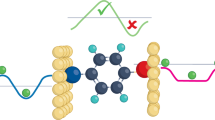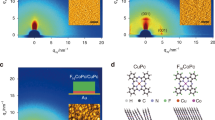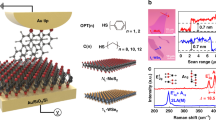Abstract
Molecular diodes operating in the tunnelling regime are intrinsically limited to a maximum rectification ratio R of ∼103. To enhance this rectification ratio to values comparable to those of conventional diodes (R ≥ 105) an alternative mechanism of rectification is therefore required. Here, we report a molecular diode with R = 6.3 × 105 based on self-assembled monolayers with Fc–C≡C–Fc (Fc, ferrocenyl) termini. The number of molecules (n(V)) involved in the charge transport changes with the polarity of the applied bias. More specifically, n(V) increases at forward bias because of an attractive electrostatic force between the positively charged Fc units and the negatively charged top electrode, but remains constant at reverse bias when the Fc units are neutral and interact weakly with the positively charged electrode. We successfully model this mechanism using molecular dynamics calculations.
This is a preview of subscription content, access via your institution
Access options
Access Nature and 54 other Nature Portfolio journals
Get Nature+, our best-value online-access subscription
$29.99 / 30 days
cancel any time
Subscribe to this journal
Receive 12 print issues and online access
$259.00 per year
only $21.58 per issue
Buy this article
- Purchase on Springer Link
- Instant access to full article PDF
Prices may be subject to local taxes which are calculated during checkout





Similar content being viewed by others
References
Benz, F. et al. Single-molecule optomechanics in ‘picocavities’. Science 354, 726–729 (2016).
Tan, S. F. et al. Quantum plasmon resonances controlled by molecular tunnel junctions. Science 343, 1496–1499 (2014).
Jia, C. et al. Covalently bonded single-molecule junctions with stable and reversible photoswitched conductivity. Science 352, 1443–1445 (2016).
Rincon-Garcia, L. et al. Molecular design and control of fullerene-based bi-thermoelectric materials. Nat. Mater. 15, 289–293 (2016).
Perrin, M. L. et al. Large negative differential conductance in single-molecule break junctions. Nat. Nanotech. 9, 830–834 (2014).
Aviram, A. & Ratner, M. A. Molecular rectifiers. Chem. Phys. Lett. 29, 277–283 (1974).
Geddes, N. J., Sambles, J. R., Jarvis, D. J., Parker, W. G. & Sandman, D. J. Fabrication and investigation of asymmetric current–voltage characteristics of a metal/Langmuir–Blodgett monolayer/metal structure. Appl. Phys. Lett. 56, 1916–1918 (1990).
Guliants, E. A., Ji, C. H., Song, Y. J. & Anderson, W. A. A 0.5-µm-thick polycrystalline silicon Schottky diode with rectification ratio of 106. Appl. Phys. Lett. 80, 1474–1476 (2002).
Tung, R. T. Recent advances in Schottky barrier concepts. Mater. Sci. Eng. R 35, 1–138 (2001).
Beck, P. A., Nickel, J. H. & Hartwell, P. G. High current density in µc-Si PECVD diodes for low temperature applications. MRS Proceedings 808, A4.30 (2004).
Prince, M. B. Diffused p–n junction silicon rectifiers. Bell Syst. Tech. J. 35, 661–684 (1956).
Capozzi, B. et al. Single-molecule diodes with high rectification ratios through environmental control. Nat. Nanotech. 10, 522–527 (2015).
Yuan, L., Breuer, R., Jiang, L., Schmittel, M. & Nijhuis, C. A. A molecular diode with a statistically robust rectification ratio of three orders of magnitude. Nano. Lett. 15, 5506–5512 (2015).
Perrin, M. L. et al. A gate-tunable single-molecule diode. Nanoscale 8, 8919–8923 (2016).
Metzger, R. M. Unimolecular electronics. Chem. Rev. 115, 5056–5115 (2015).
Kornilovitch, P. E., Bratkovsky, A. M. & Stanley Williams, R. Current rectification by molecules with asymmetric tunnelling barriers. Phys. Rev. B 66, 165436 (2002).
Nijhuis, C. A., Reus, W. F. & Whitesides, G. M. Mechanism of rectification in tunnelling junctions based on molecules with asymmetric potential drops. J. Am. Chem. Soc. 132, 18386–18401 (2010).
Kovalchuk, A. et al. Dipole-induced asymmetric conduction in tunnelling junctions comprising self-assembled monolayers. RSC Adv. 6, 69479–69483 (2016).
Van Dyck, C. & Ratner, M. A. Molecular rectifiers: a new design based on asymmetric anchoring moieties. Nano Lett. 15, 1577–1584 (2015).
Guo, C. et al. Molecular rectifier composed of DNA with high rectification ratio enabled by intercalation. Nat. Chem. 8, 484–490 (2016).
Garrigues, A. R. et al. A single-level tunnel model to account for electrical transport through single molecule- and self-assembled monolayer-based junctions. Sci. Rep. 6, 26517 (2016).
Chiechi, R. C., Weiss, E. A., Dickey, M. D. & Whitesides, G. M. Eutectic gallium–indium (EGaIn): a moldable liquid metal for electrical characterization of self-assembled monolayers. Angew. Chem. Int. Ed. 47, 142–144 (2008).
Thompson, D. & Nijhuis, C. A. Even the odd numbers help: failure modes of SAM-based tunnel junctions probed via odd–even effects revealed in synchrotrons and supercomputers. Acc. Chem. Res. 49, 2061–2069 (2016).
Song, P., Yuan, L., Roemer, M., Jiang, L. & Nijhuis, C. A. Supramolecular vs electronic structure: the effect of the tilt angle of the active group in the performance of a molecular diode. J. Am. Chem. Soc. 138, 5769–5772 (2016).
Nerngchamnong, N. et al. The role of van der Waals forces in the performance of molecular diodes. Nat. Nanotech. 8, 113–118 (2013).
Fukagawa, H. et al. The role of the ionization potential in vacuum-level alignment at organic semiconductor interfaces. Adv. Mater. 19, 665–668 (2007).
Fukagawa, H., Yamane, H., Kera, S., Okudaira, K. K. & Ueno, N. Experimental estimation of the electric dipole moment and polarizability of titanyl phthalocyanine using ultraviolet photoelectron spectroscopy. Phys. Rev. B 73, 041302 (2006).
Cahen, D., Kahn, A. & Umbach, E. Energetics of molecular interfaces. Mater. Today 8, 32–41 (2005).
Heimel, G., Romaner, L., Zojer, E. & Bredas, J.-L. The interface energetics of self-assembled monolayers on metals. Acc. Chem. Res. 41, 721–729 (2008).
Nijhuis, C. A., Reus, W. F., Barber, J. R., Dickey, M. D. & Whitesides, G. M. Charge transport and rectification in arrays of SAM-based tunnelling junctions. Nano Lett. 10, 3611–3619 (2010).
Garrigues, A. R., Wang, L., del Barco, E. & Nijhuis, C. A. Electrostatic control over temperature-dependent tunnelling across a single-molecule junction. Nat. Commun. 7, 11595 (2016).
Du, W. et al. On-chip molecular electronic plasmon sources based on self-assembled monolayer tunnel junctions. Nat. Photon. 10, 274–280 (2016).
Nerngchamnong, N. et al. Nonideal electrochemical behavior of ferrocenyl-alkanethiolate SAMs maps the microenvironment of the redox unit. J. Phys. Chem. C 119, 21978–21991 (2015).
Trasobares, J., Vuillaume, D., Théron, D. & Clément, N. A 17 GHz molecular rectifier. Nat. Commun. 7, 12850 (2016).
Nijhuis, C. A., Reus, W. F. & Whitesides, G. M. Molecular rectification in metal−SAM−metal oxide−metal junctions. J. Am. Chem. Soc. 131, 17814–17827 (2009).
Acknowledgements
The authors thank the Ministry of Education (MOE) for supporting this research under award no. MOE2015-T2-1-050. The Prime Minister's Office, Singapore, under its Medium Sized Centre programme, is also acknowledged for supporting this research. The authors thank T. Wang for assisting in the analysis of the optical data and L. Jiang for providing the Au and Ag substrates. D.T. acknowledges Science Foundation Ireland (SFI) for financial support under grant no. 15/CDA/3491, and for provision of computing resources at the SFI/Higher Education Authority Irish Centre for High-End Computing (ICHEC). E.d.B. acknowledges support from the National Science Foundation (grants numbers NSF-ECCS 1402990 and 1518863). The authors thank Y. Xiaojiang for assisting at the SINS beamline at SSLS under NUS core support C-380-003-003-001.
Author information
Authors and Affiliations
Contributions
X.C. and L.Y. performed electrical characterization and analysed the data. M.R. synthesized the compounds. L.Y. performed the XPS, ultraviolet photoelecton spectroscopy and near-edge X-ray fine structure spectroscopy measurements. W.D. carried out the optical measurement. D.T. computed the molecular dynamics. E.d.B. modelled the junction data. C.A.N. conceptualized and led the study. All authors discussed the results, contributed to writing the paper and commented on the manuscript.
Corresponding author
Ethics declarations
Competing interests
The authors declare no competing financial interests.
Supplementary information
Supplementary information
Supplementary information (PDF 4044 kb)
Supplementary information
Supplementary Movie (MOV 1862 kb)
Rights and permissions
About this article
Cite this article
Chen, X., Roemer, M., Yuan, L. et al. Molecular diodes with rectification ratios exceeding 105 driven by electrostatic interactions. Nature Nanotech 12, 797–803 (2017). https://doi.org/10.1038/nnano.2017.110
Received:
Accepted:
Published:
Issue Date:
DOI: https://doi.org/10.1038/nnano.2017.110
This article is cited by
-
Photooxidation driven formation of Fe-Au linked ferrocene-based single-molecule junctions
Nature Communications (2024)
-
First-Principles Approach to Elucidating Significant Rectification Ratios in Oppositely Charged Dipeptides
Journal of Electronic Materials (2024)
-
Dielectric polymer grafted electrodes enhanced aqueous supercapacitors
Nano Research (2024)
-
Nanoscale molecular rectifiers
Nature Reviews Chemistry (2023)
-
An artificial synapse based on molecular junctions
Nature Communications (2023)



